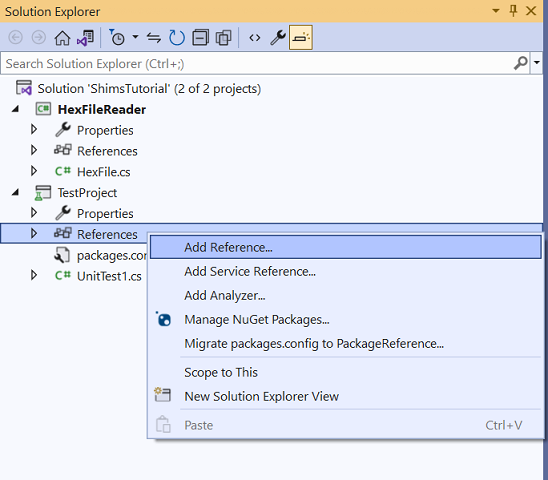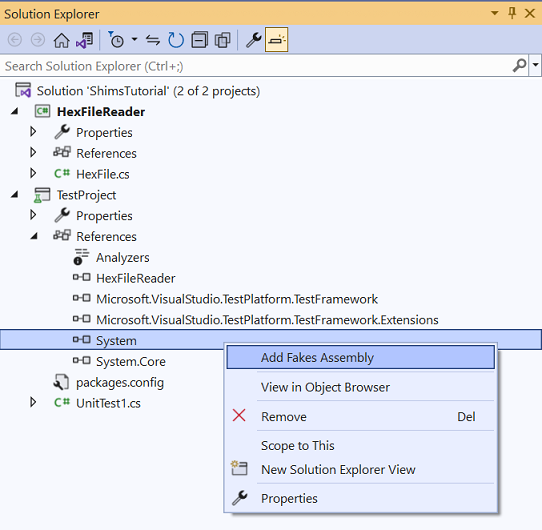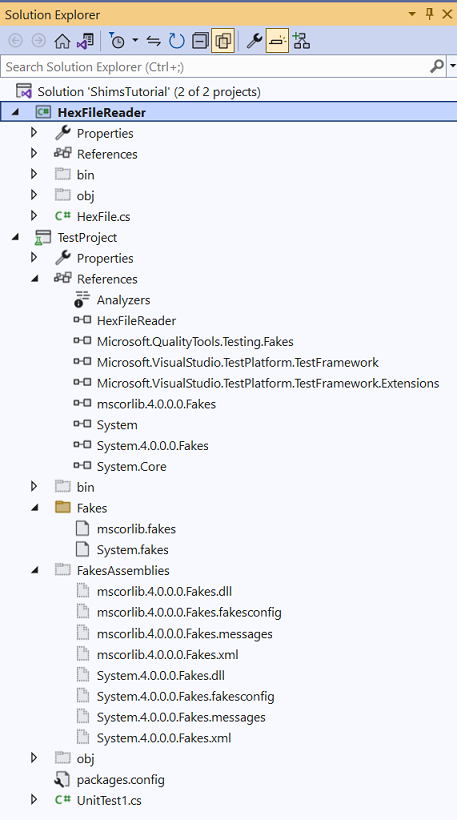Use shims to isolate your app for unit testing
Shim types, one of the two key technologies utilized by the Microsoft Fakes Framework, are instrumental in isolating the components of your app during testing. They work by intercepting and diverting calls to specific methods, which you can then direct to custom code within your test. This feature enables you to manage the outcome of these methods, ensuring the results are consistent and predictable during each call, regardless of external conditions. This level of control streamlines the testing process and aids in achieving more reliable and accurate results.
Employ shims when you need to create a boundary between your code and assemblies that do not form part of your solution. When the aim is to isolate components of your solution from each other, the use of stubs is recommended.
(For a more detailed description for stubs, see Use stubs to isolate parts of your application from each other for unit testing.)
Shims limitations
It is important to note that shims do have their limitations.
Shims cannot be used on all types from certain libraries in the .NET base class, specifically mscorlib and System in the .NET Framework, and in System.Runtime in .NET Core or .NET 5+. This constraint should be taken into account during the test planning and design stage to ensure a successful and effective testing strategy.
Creating a Shim: A Step-by-Step Guide
Suppose your component contains calls to System.IO.File.ReadAllLines:
// Code under test:
this.Records = System.IO.File.ReadAllLines(path);
Create a Class Library
Open Visual Studio and create a
Class Libraryproject
Set project name
HexFileReaderSet solution name
ShimsTutorial.Set the project's target framework to .NET Framework 4.8
Delete the default file
Class1.csAdd a new file
HexFile.csand add the following class definition:
Create a Test Project
Right-click on the solution and add a new project
MSTest Test ProjectSet project name
TestProjectSet the project's target framework to .NET Framework 4.8

Add Fakes Assembly
Add a project reference to
HexFileReader
Add Fakes Assembly
In Solution Explorer,
For an older .NET Framework Project (non-SDK style), expand your unit test project's References node.
For an SDK-style project targeting .NET Framework, .NET Core, or .NET 5+, expand the Dependencies node to find the assembly you would like to fake under Assemblies, Projects, or Packages.
If you're working in Visual Basic, select Show All Files in the Solution Explorer toolbar to see the References node.
Select the assembly
Systemthat contains the definition ofSystem.IO.File.ReadAllLines.On the shortcut menu, select Add Fakes Assembly.

Since building results in some warnings and errors because not all types can be used with shims, you will have to modify the content of Fakes\mscorlib.fakes to exclude them.
<Fakes xmlns="http://schemas.microsoft.com/fakes/2011/" Diagnostic="true">
<Assembly Name="mscorlib" Version="4.0.0.0"/>
<StubGeneration>
<Clear/>
</StubGeneration>
<ShimGeneration>
<Clear/>
<Add FullName="System.IO.File"/>
<Remove FullName="System.IO.FileStreamAsyncResult"/>
<Remove FullName="System.IO.FileSystemEnumerableFactory"/>
<Remove FullName="System.IO.FileInfoResultHandler"/>
<Remove FullName="System.IO.FileSystemInfoResultHandler"/>
<Remove FullName="System.IO.FileStream+FileStreamReadWriteTask"/>
<Remove FullName="System.IO.FileSystemEnumerableIterator"/>
</ShimGeneration>
</Fakes>
Create a unit test
Modify the default file
UnitTest1.csto add the followingTestMethod[TestMethod] public void TestFileReadAllLine() { using (ShimsContext.Create()) { // Arrange System.IO.Fakes.ShimFile.ReadAllLinesString = (s) => new string[] { "Hello", "World", "Shims" }; // Act var target = new HexFile("this_file_doesnt_exist.txt"); Assert.AreEqual(3, target.Records.Length); } }Here is the Solution Explorer showing all the files

Open Test Explorer and run the test.
It's critical to properly dispose each shim context. As a rule of thumb, call the ShimsContext.Create inside of a using statement to ensure proper clearing of the registered shims. For example, you might register a shim for a test method that replaces the DateTime.Now method with a delegate that always returns the first of January 2000. If you forget to clear the registered shim in the test method, the rest of the test run would always return the first of January 2000 as the DateTime.Now value. This might be surprising and confusing.
Naming Conventions for Shim Classes
Shim class names are made up by prefixing Fakes.Shim to the original type name. Parameter names are appended to the method name. (You don't have to add any assembly reference to System.Fakes.)
System.IO.File.ReadAllLines(path);
System.IO.Fakes.ShimFile.ReadAllLinesString = (path) => new string[] { "Hello", "World", "Shims" };
Understanding How Shims Work
Shims operate by introducing detours into the codebase of the application being tested. Whenever there's a call to the original method, the Fakes system intervenes to redirect that call, causing your custom shim code to execute instead of the original method.
It's important to note that these detours are created and removed dynamically at runtime. Detours should always be created within the lifespan of a ShimsContext. When the ShimsContext is disposed, any active shims that were created within it are also removed. To manage this efficiently, it's recommended to encapsulate the creation of detours within a using statement.
Shims for different kinds of methods
Shims support various types of methods.
Static methods
When shimming static methods, properties that hold shims are housed within a shim type. These properties only possess a setter, which is used to attach a delegate to the targeted method. For instance, if we have a class called MyClass with a static method MyMethod:
//code under test
public static class MyClass {
public static int MyMethod() {
...
}
}
We can attach a shim to MyMethod such that it constantly returns 5:
// unit test code
ShimMyClass.MyMethod = () => 5;
Instance methods (for all instances)
Just like static methods, instance methods can also be shimmed for all instances. The properties that hold these shims are placed in a nested type named AllInstances to prevent confusion. If we have a class MyClass with an instance method MyMethod:
// code under test
public class MyClass {
public int MyMethod() {
...
}
}
We can attach a shim to MyMethod so that it consistently returns 5, regardless of the instance:
// unit test code
ShimMyClass.AllInstances.MyMethod = () => 5;
The generated type structure of ShimMyClass would appear as follows:
// Fakes generated code
public class ShimMyClass : ShimBase<MyClass> {
public static class AllInstances {
public static Func<MyClass, int>MyMethod {
set {
...
}
}
}
}
In this scenario, Fakes passes the runtime instance as the first argument of the delegate.
Instance methods (Single Runtime Instance)
Instance methods can also be shimmed using different delegates, depending on the call's receiver. This allows the same instance method to exhibit different behaviors per instance of the type. The properties that hold these shims are instance methods of the shim type itself. Each instantiated shim type is linked to a raw instance of a shimmed type.
For example, given a class MyClass with an instance method MyMethod:
// code under test
public class MyClass {
public int MyMethod() {
...
}
}
We can create two shim types for MyMethod such that the first consistently returns 5 and the second consistently returns 10:
// unit test code
var myClass1 = new ShimMyClass()
{
MyMethod = () => 5
};
var myClass2 = new ShimMyClass { MyMethod = () => 10 };
The generated type structure of ShimMyClass would appear as follows:
// Fakes generated code
public class ShimMyClass : ShimBase<MyClass> {
public Func<int> MyMethod {
set {
...
}
}
public MyClass Instance {
get {
...
}
}
}
The actual shimmed type instance can be accessed through the Instance property:
// unit test code
var shim = new ShimMyClass();
var instance = shim.Instance;
The shim type also includes an implicit conversion to the shimmed type, allowing you to use the shim type directly:
// unit test code
var shim = new ShimMyClass();
MyClass instance = shim; // implicit cast retrieves the runtime instance
Constructors
Constructors are no exception to shimming; they too can be shimmed to attach shim types to objects that will be created in the future. For instance, every constructor is represented as a static method, named Constructor, within the shim type. Let's consider a class MyClass with a constructor that accepts an integer:
public class MyClass {
public MyClass(int value) {
this.Value = value;
}
...
}
A shim type for the constructor can be set up such that, irrespective of the value passed to the constructor, every future instance will return -5 when the Value getter is invoked:
// unit test code
ShimMyClass.ConstructorInt32 = (@this, value) => {
var shim = new ShimMyClass(@this) {
ValueGet = () => -5
};
};
Each shim type exposes two types of constructors. The default constructor should be used when a new instance is needed, whereas the constructor that takes a shimmed instance as an argument should only be used in constructor shims:
// unit test code
public ShimMyClass() { }
public ShimMyClass(MyClass instance) : base(instance) { }
The structure of the generated type for ShimMyClass can be illustrated as follows:
// Fakes generated code
public class ShimMyClass : ShimBase<MyClass>
{
public static Action<MyClass, int> ConstructorInt32 {
set {
...
}
}
public ShimMyClass() { }
public ShimMyClass(MyClass instance) : base(instance) { }
...
}
Accessing Base members
Shim properties of base members can be reached by creating a shim for the base type and inputting the child instance into the constructor of the base shim class.
For instance, consider a class MyBase with an instance method MyMethod and a subtype MyChild:
public abstract class MyBase {
public int MyMethod() {
...
}
}
public class MyChild : MyBase {
}
A shim of MyBase can be set up by initiating a new ShimMyBase shim:
// unit test code
var child = new ShimMyChild();
new ShimMyBase(child) { MyMethod = () => 5 };
It's important to note that when passed as a parameter to the base shim constructor, the child shim type is implicitly converted to the child instance.
The structure of the generated type for ShimMyChild and ShimMyBase can be likened to the following code:
// Fakes generated code
public class ShimMyChild : ShimBase<MyChild> {
public ShimMyChild() { }
public ShimMyChild(Child child)
: base(child) { }
}
public class ShimMyBase : ShimBase<MyBase> {
public ShimMyBase(Base target) { }
public Func<int> MyMethod
{ set { ... } }
}
Static constructors
Shim types expose a static method StaticConstructor to shim the static constructor of a type. Since static constructors are executed once only, you need to make sure that the shim is configured before any member of the type is accessed.
Finalizers
Finalizers are not supported in Fakes.
Private methods
The Fakes code generator creates shim properties for private methods that only have visible types in the signature, that is, parameter types and return type visible.
Binding interfaces
When a shimmed type implements an interface, the code generator emits a method that allows it to bind all the members from that interface at once.
For example, given a class MyClass that implements IEnumerable<int>:
public class MyClass : IEnumerable<int> {
public IEnumerator<int> GetEnumerator() {
...
}
...
}
You can shim the implementations of IEnumerable<int> in MyClass by calling the Bind method:
// unit test code
var shimMyClass = new ShimMyClass();
shimMyClass.Bind(new List<int> { 1, 2, 3 });
The generated type structure of ShimMyClass resembles the following code:
// Fakes generated code
public class ShimMyClass : ShimBase<MyClass> {
public ShimMyClass Bind(IEnumerable<int> target) {
...
}
}
Change Default Behavior
Each generated shim type includes an instance of the IShimBehavior interface, accessible via the ShimBase<T>.InstanceBehavior property. This behavior is invoked whenever a client calls an instance member that has not been explicitly shimmed.
By default, if no specific behavior has been set, it uses the instance returned by the static ShimBehaviors.Current property, which typically throws a NotImplementedException exception.
You can modify this behavior at any time by adjusting the InstanceBehavior property for any shim instance. For instance, the following code snippet alters the behavior to either do nothing or return the default value of the return type—i.e., default(T):
// unit test code
var shim = new ShimMyClass();
//return default(T) or do nothing
shim.InstanceBehavior = ShimBehaviors.DefaultValue;
You can also globally change the behavior for all shimmed instances—where the InstanceBehavior property has not been explicitly defined—by setting the static ShimBehaviors.Current property:
// unit test code
// change default shim for all shim instances where the behavior has not been set
ShimBehaviors.Current = ShimBehaviors.DefaultValue;
Identifying Interactions with External Dependencies
To help identify when your code is interacting with external systems or dependencies (referred to as the environment), you can utilize shims to assign a specific behavior to all members of a type. This includes static methods. By setting the ShimBehaviors.NotImplemented behavior on the static Behavior property of the shim type, any access to a member of that type that hasn't been explicitly shimmed will throw a NotImplementedException. This can serve as a useful signal during testing, indicating that your code is attempting to access an external system or dependency.
Here's an example of how to set this up in your unit test code:
// unit test code
// Assign the NotImplementedException behavior to ShimMyClass
ShimMyClass.Behavior = ShimBehaviors.NotImplemented;
For convenience, a shorthand method is also provided to achieve the same effect:
// Shorthand to assign the NotImplementedException behavior to ShimMyClass
ShimMyClass.BehaveAsNotImplemented();
Invoking Original Methods from Within Shim Methods
There could be scenarios where you might need to execute the original method during the execution of the shim method. For instance, you might want to write text to the file system after validating the file name passed to the method.
One approach to handle this situation is to encapsulate a call to the original method using a delegate and ShimsContext.ExecuteWithoutShims(), as demonstrated in the following code:
// unit test code
ShimFile.WriteAllTextStringString = (fileName, content) => {
ShimsContext.ExecuteWithoutShims(() => {
Console.WriteLine("enter");
File.WriteAllText(fileName, content);
Console.WriteLine("leave");
});
};
Alternatively, you can nullify the shim, call the original method, and then restore the shim.
// unit test code
ShimsDelegates.Action<string, string> shim = null;
shim = (fileName, content) => {
try {
Console.WriteLine("enter");
// remove shim in order to call original method
ShimFile.WriteAllTextStringString = null;
File.WriteAllText(fileName, content);
}
finally
{
// restore shim
ShimFile.WriteAllTextStringString = shim;
Console.WriteLine("leave");
}
};
// initialize the shim
ShimFile.WriteAllTextStringString = shim;
Handling Concurrency with Shim Types
Shim types operate across all threads within the AppDomain and do not possess thread affinity. This property is crucial to keep in mind if you plan to utilize a test runner that supports concurrency. It's worth noting that tests involving shim types cannot run concurrently, although this restriction is not enforced by the Fakes runtime.
Shimming System.Environment
If you wish to shim the System.Environment class, you'll need to make some modifications to the mscorlib.fakes file. Following the Assembly element, add the following content:
<ShimGeneration>
<Add FullName="System.Environment"/>
</ShimGeneration>
Once you have made these changes and rebuilt the solution, the methods and properties in the System.Environment class are now available to be shimmed. Here's an example of how you can assign a behavior to the GetCommandLineArgsGet method:
System.Fakes.ShimEnvironment.GetCommandLineArgsGet = ...
By making these modifications, you've opened up the possibility to control and test how your code interacts with system environment variables, an essential tool for comprehensive unit testing.